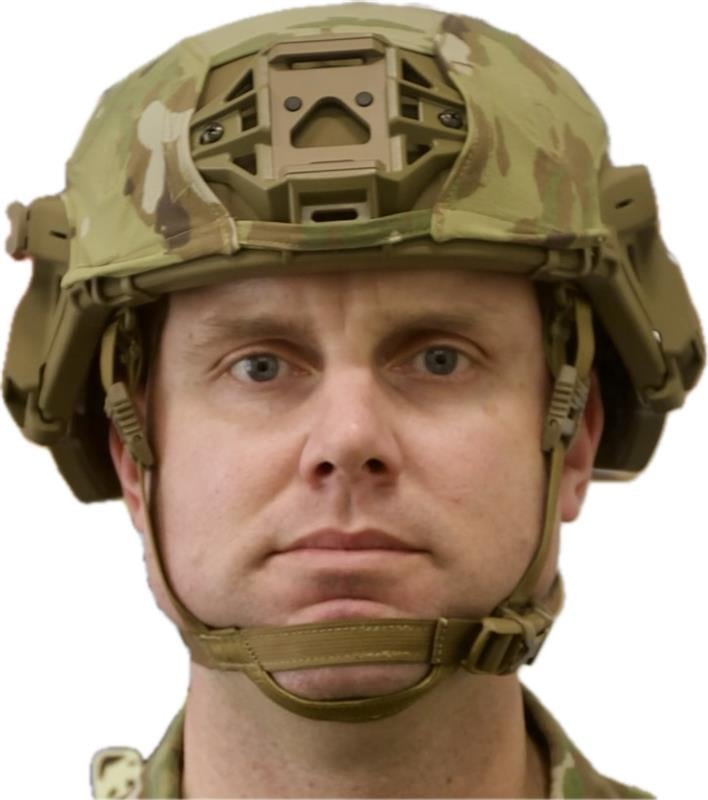Paratroopers with the 82nd Airborne Division received the Army’s newest helmet today, the first combat helmet capable of withstanding small arms fire without added protection.
The Next Generation Integrated Head Protection System is a 3.27 pound helmet — in its large size — that may look identical to its predecessor, the Integrated Head Protection System, but offers another level of protection, officials told Army Times.
Starting today, 1st, 2nd and 3rd Brigade Combat Teams at the division will receive the new helmet, starting with 2,000 soldiers from 1st brigade.
The previous version of the IHPS was 5% lighter than the more widely fielded Advanced Combat Helmet, which is still in use across the Army. The older IHPS, which Program Executive Office-Soldier began fielding in 2018 to replace both the Advanced Combat Helmet and the Enhanced Combat Helmet for close combat units, provided better blunt force protection at a lighter weight than the older models.
“The (helmet) provides increased ballistic and fragmentation protection while reducing the weight required to previously reach this protection level by 40%,” said Maj. Matthew Nulk, assistant program manager of the Head Protection Team. “This is world-leading rifle threat protection we’re providing to our soldiers.”
The Army fielded an estimated 119,000 IHPS models across the force between 2018 and 2022, said Lt. Col. Kenneth Elgort, program manager for soldier protective systems.
But its ballistic protection was still limited to pistol rounds and fragmentation. Soldiers could attach an applique, meanwhile, for small arms protection, but that accessory, which added 2.5 pounds to the system, proved too cumbersome and was rarely used, officials said.
Advances in polymers allowed designers to develop the next generation version of the helmet at the same weight but with greater protection, Alex De Groot, lead engineer for head protection at PEO Soldier, told Army Times.
Older helmets are made from materials called aramids, commonly known by the commercial name Kevlar, De Groot added. That hard, brittle material protects by disintegrating on impact. But polyethylene, the newer material being used, “acts like a catcher’s mitt,” De Groot said. The material deforms on impact, dissipating energy.

The service expects to field 190,000 next generation IHPS by 2028, Elgort said. The new helmet comes in small, medium, large and extra large sizes.
The next generation version is being built by Gentex Corporation and Avon Protection Ceradyne, officials said. Developers are still working on improving the new helmet even as it fields.
Soldier feedback during testing noted stiff front pads inside the helmet, Elgort said. In response, designers have come up with four new pad options that soldiers with the 101st Airborne Division will test and provide feedback on this spring. The office expects to begin fielding the best pad option in early 2025.
At the same time, PEO Soldier recently stood up a team to integrate a combination of communications and hearing protection system into the new helmet, Elgort said. That effort is expected to run through research, development, testing and engineering over the next two years.
The non-close combat force, which makes up the majority of the service, will continue to use the ACH, which is also being upgraded. Soldiers this year will test a 15% lighter version of the ACH. The first generation ACH weighed 3.31 pounds, while the version being tested weighs 2.81 pounds.
The Army’s current fielding plan for the next generation IHPS, according to the Program Executive Office-Soldier, is:
- February-March: 1st, 2nd and 3rd Brigade Combat Teams, 82nd Airborne Division, followed by 2nd Security Force Assistance Brigade, Fort Liberty, North Carolina.
- Third Quarter Fiscal 2024: 1st, 2nd, 3rd Brigade Combat Teams, 101st Airborne Division, Fort Campbell, Kentucky.
- Late summer: 3rd Security Force Assistance Brigade, Fort Cavazos, Texas, followed by 2nd Brigade Combat Team, 10th Mountain Division, Fort Drum, New York.
- Fourth Quarter Fiscal 2024: 4th Security Force Assistance Brigade, Fort Carson, Colorado; 5th Security Force Assistance Brigade, Joint Base Lewis-McChord, Washington.
- Fiscal 2025: 173rd Airborne Brigade, Vicenza, Italy; 2nd Cavalry Regiment, Vilseck, Germany; 1st Brigade, 11th Airborne Division, Fort Wainwright, Alaska.
*UPDATE: This article has been updated to include additional information about the helmet fielding provided by PEO-Soldier.
Todd South has written about crime, courts, government and the military for multiple publications since 2004 and was named a 2014 Pulitzer finalist for a co-written project on witness intimidation. Todd is a Marine veteran of the Iraq War.






